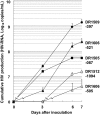Intrinsic Replication Competences of HIV Strains After Zidovudine/Lamivudine/Nevirapine Treatment in the Philippines
- PMID: 31216920
- PMCID: PMC6748504
- DOI: 10.1177/2325958219856579
Intrinsic Replication Competences of HIV Strains After Zidovudine/Lamivudine/Nevirapine Treatment in the Philippines
Abstract
Although drug-resistant HIV variants are considered to be less fit than drug-susceptible viruses, replication competence of these variants harbored by patients has not yet been elucidated in detail. We herein assessed the replication competence of strains obtained from individuals receiving antiretroviral therapy. Among 11 306 participants in a drug resistance surveillance in the Philippines, 2629 plasma samples were obtained from individuals after a 12-month treatment with zidovudine (ZDV)/lamivudine (3TC)/nevirapine (NVP). The replication competence of HIV isolates was then assessed by reinoculation into seronegative peripheral blood mononuclear cells in the absence of drugs in vitro. The drug resistance rate was estimated to be 9.2%. Drug-resistant strains were still a minority of closely related strains in a phylogenetic cluster. Among the available 295 samples, 37 HIV strains were successfully isolated. Progeny viruses were produced at a wide range (5.1 × 106 to 3.4 × 109 copies/mL) in primary culture of peripheral blood mononuclear cells. The viral yields were higher than the corresponding plasma viral load (1300 to 3.4 × 106 copies/mL) but correlated with those (r = 0.4). These results suggest that strains with higher intrinsic replication competence are one of the primary targets of newly selected drugs at the increasing phase of the plasma viral load during antiretroviral therapy.
Keywords: antiretroviral agents; drug resistance; human immunodeficiency virus; microbial cultures; virulence.
Conflict of interest statement
Figures




Similar articles
-
Maternal 12-month response to antiretroviral therapy following prevention of mother-to-child transmission of HIV type 1, Ivory Coast, 2003-2006.Clin Infect Dis. 2008 Feb 15;46(4):611-21. doi: 10.1086/526780. Clin Infect Dis. 2008. PMID: 18197758
-
Low rate of emergence of nevirapine and lamivudine resistance after post-partum interruption of a triple-drug regimen.Antivir Ther. 2008;13(1):135-9. Antivir Ther. 2008. PMID: 18389908
-
Field assessment of generic antiretroviral drugs: a prospective cohort study in Cameroon.Antivir Ther. 2005;10(2):335-41. Antivir Ther. 2005. PMID: 15865228 Clinical Trial.
-
Prevalence and incidence of resistance to zidovudine and other antiretroviral drugs.Am J Med. 1997 May 19;102(5B):70-5. doi: 10.1016/s0002-9343(97)00067-3. Am J Med. 1997. PMID: 9845501 Review.
-
Factors associated with viral suppression and rebound among adult HIV patients on treatment: a retrospective study in Ghana.AIDS Res Ther. 2022 May 25;19(1):21. doi: 10.1186/s12981-022-00447-2. AIDS Res Ther. 2022. PMID: 35614510 Free PMC article. Review.
Cited by
-
In Vitro Susceptibility of HIV Isolates with High Growth Capability to Antiretroviral Drugs.Int J Mol Sci. 2022 Dec 6;23(23):15380. doi: 10.3390/ijms232315380. Int J Mol Sci. 2022. PMID: 36499705 Free PMC article.
-
HIV and Drug-Resistant Subtypes.Microorganisms. 2023 Jan 15;11(1):221. doi: 10.3390/microorganisms11010221. Microorganisms. 2023. PMID: 36677513 Free PMC article. Review.
References
-
- Rerks-Ngarm S, Pitisuttithum P, Nitayaphan S, et al. Vaccination with ALVAC and AIDSVAX to prevent HIV-1 infection in thailand. N Engl J Med. 2009;361(23):2209–2220. doi:10.1056/NEJMoa0908492. - PubMed
Publication types
MeSH terms
Substances
LinkOut - more resources
Full Text Sources
Medical

